On the aerodynamic optimization of mini-RPV ... - CAFE Foundation
On the aerodynamic optimization of mini-RPV ... - CAFE Foundation
On the aerodynamic optimization of mini-RPV ... - CAFE Foundation
You also want an ePaper? Increase the reach of your titles
YUMPU automatically turns print PDFs into web optimized ePapers that Google loves.
~Mini -<strong>RPV</strong>L& 9,- '\FreeTransiiionfiConi. Wake1 andTransitionTripped B 58% 0I I I I I0.01 0.02 0.03 0.04 0.050.66Thrust Ccefficient CT = T/q V0Fig. 11 Jet total-head coefficient CHT, vSThrust coefficient CTMini-<strong>RPV</strong> <strong>aerodynamic</strong> design has not achieved yetan adequate degree <strong>of</strong> efficiency for <strong>the</strong> missionspeed and endurance requirements. Considering typicalcurrent vehicles such as <strong>the</strong> Air Force/BoeingPave Tiger, <strong>the</strong> Atmy/Lockheed Aquila, <strong>the</strong> Israel WAircraft industries Scout, <strong>the</strong> Tadiran Mastiff MK3and <strong>the</strong> Developmental Sciences Sky Eye, it is foundthat <strong>the</strong> gross weight ranges from 220 to 380 lb,<strong>the</strong> maximum cruising speed ranges from 85 to 100Kn and <strong>the</strong> engine powers range from 22 to 30 HP.The <strong>aerodynamic</strong> efficiency index ranges from 2.5to 3.5.The wind-tunnel test model,2"'4 with its diameterD = 20.0 in. and 100 Kn speed, may be classifiedas a full-scale <strong>mini</strong>-<strong>RPV</strong>; Table 1 presents itsperformance data for 125, 150 and 175 lb grossweights with a suitable wing (CL = 0.40) and empennage.Table 1 20" Diameter (V = 6.2 ft3) Mini-<strong>RPV</strong>P 100 Kn (qo = 34.1 PSF)(Free Transition)1.8 I I I I1Gross Weight W, lbWing loading qoCL @ CL= 0.4PSF125 It13.6150 lb13.6175 lb13.60. 2 c01001 lo-II I I I J0.01 0.02 0. m 0. M 0.05Thrust Ccefficient CT = TPoVo'66Fig. 12 Jet velocity-ratio U,/U,coefficient CT1.4, I I I Ivs ThrustI I I I I0 0.01 0.02 0.03 0.M 0.05Thrust Ccefliclent Cl =T/qoVo'MFig. 13 Jet static base pressure coefficient CP,Thrust coefficient CTIvsWing area A = Wo/qoCL, ft2Wing chord, C ftWing span, B ftLift/drag ratio <strong>of</strong> wing,CL/CD @ CL = 0.40Drag <strong>of</strong> wing, Fw = WCLo / ~Thrust coeff. for wingCTwTotal thrust coeff. CTaFan air power coeff. CHP,Fan flow coeff. CQ,Fan flow 9CFSFan pressure-risecoeff.CHzsFan pressure-riseAH2 iPSFFan system-resi stancecoeff.@2/*Fan speed, nRPMFan diameter, d, in.Fan efficiency, '?F %Fan shaft powerHPJet total-head coeff. CHT5Jet velocity ratio U,/UoJet static basepressure coeff.cp5Aerodynamic efficiency F.index9.190.9589.5837.63.320.02850.034E0.0600.023713.502.5486.360.78533,9643.2589.752.352.661.351.0416.3411.031.05010.5037.63.990.03480.04120.06850.025214.352.8095.200.80535,7563.2590.502.782.901.421.1017.20__12.861.13411.3437.64.651.04061.04761.07551.026415.033.05103.700.81137,3113.2590.753.123.161.511.1018.22V6
















